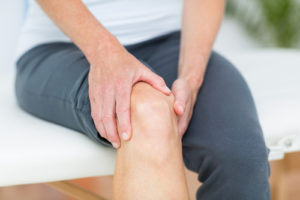
The knee is one of the most important, and used, joints in the human body. Because of its nearly constant utilization, the knee also sustains a considerable amount of stress and can be injured. One of the most common injuries to the knee is called runner’s knee, and–though generally easy to treat–it can be a painful experience. Here is a brief description of runner’s knee, as well as some advice on treating it.
Runner’s Knee Symptoms
Known officially as patellofemoral pain syndrome, runner’s knee presents itself as pain on the front, side, or back of the knee cap. This pain typically occurs during activities like running, jumping, squatting, and even standing after long periods of sitting. Normally, when bending the knee, the patella slides through a groove in the femur. Runner’s knee occurs when there is excess stress between the femur and patella.
Runner’s Knee Causes
This stress can be caused by numerous things. Tight hips, thighs, or calves can cause the kneecap to track incorrectly, resulting in pain. Making sure to warm up and stretch muscles, focusing on flexibility, can help alleviate and prevent pain. But inflexibility in these muscles isn’t the only potential problem. Having a muscle imbalance (some muscles are too weak while others are too strong) can also interfere with the natural movement of the knee joint.
RICE
Fortunately, runner’s knee typically does not require surgery. If a physician suspects patellofemoral pain syndrome, RICE (Rest, Ice, Compression, and Elevation) is usually prescribed.
- Giving the body time to heal is the most important thing. Even once the pain has subsided, athletes should not return immediately to their former intensity levels. Instead, they should carefully return to activity, monitoring the pain in their knee and making adjustments as necessary.
- Icing the joint simultaneously limits pain and inflammation, allowing the tendons to heal. Avoid placing ice directly on the skin of the affected area, as this can cause damage to the skin. Ice should not be left on the joint for longer than 10 to 20 minutes. If necessary, the knee can be iced several times a day, but sessions should not last longer than 20 minutes.
- Compression helps the joint track properly during movement, reducing pain and preventing further injury. There are a variety of compression sleeves, tapes, and braces that can help the knee function properly.
- Elevation, especially shortly after the injury, prevents blood from pooling and causing swelling in and around the joint. When elevating the knee, it can be propped up on pillows to raise the joint above the heart. Combining these self treatments can help the knee heal faster and more comfortably.
Finally, implementing stretching more often and strengthening the muscles around the knee (to prevent imbalances) is the best way to prevent further injury. Athletes should also reevaluate their form, equipment, and workout routines to reduce the risk of reinjuring the joint.
